Food Cost Accounting at Simply Indian Restaurant – Review and Proposal
VerifiedAdded on 2020/02/24
|28
|6282
|266
Report
AI Summary
This report presents a comprehensive analysis of food cost accounting at Simply Indian Restaurant, located in Lower Hutt Central, Wellington, New Zealand. The study addresses the restaurant's challenges in cost management, particularly the increasing cost levels impacting profitability. The research employs secondary data collection, a survey study for primary data, and qualitative analysis. The report includes an introduction to the restaurant industry and the organization's background, outlines the project scope, details the research methodology, and provides a literature review on costing methods and cost controls. The discussion section presents survey results, identifies solution areas, and considers limitations and ethical considerations. The report concludes with long-term and short-term recommendations for improving food cost accounting and control, aiming to enhance the restaurant's financial performance. The appendices include the survey questionnaire used in the primary data collection.
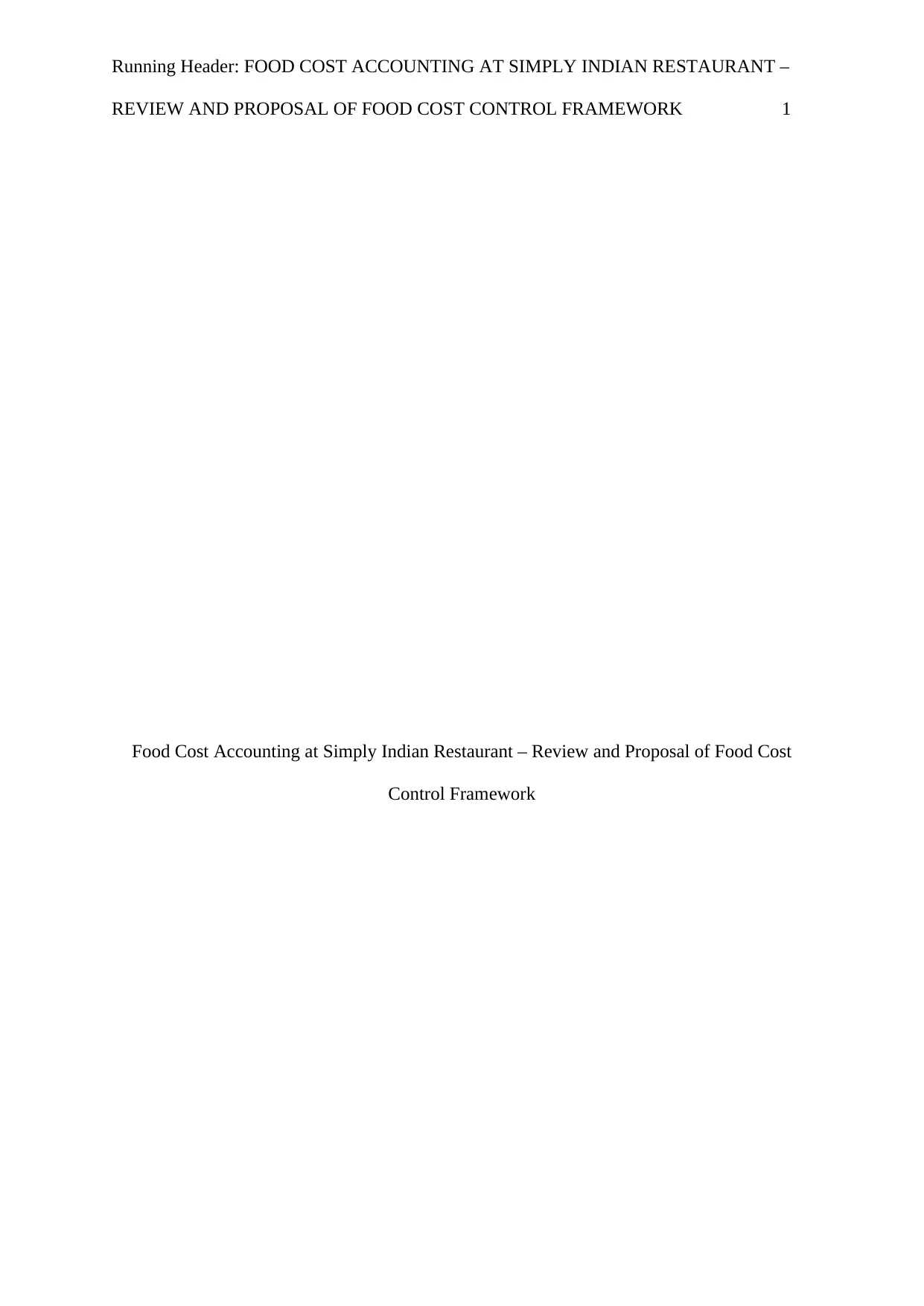
Running Header: FOOD COST ACCOUNTING AT SIMPLY INDIAN RESTAURANT –
REVIEW AND PROPOSAL OF FOOD COST CONTROL FRAMEWORK 1
Food Cost Accounting at Simply Indian Restaurant – Review and Proposal of Food Cost
Control Framework
REVIEW AND PROPOSAL OF FOOD COST CONTROL FRAMEWORK 1
Food Cost Accounting at Simply Indian Restaurant – Review and Proposal of Food Cost
Control Framework
Paraphrase This Document
Need a fresh take? Get an instant paraphrase of this document with our AI Paraphraser
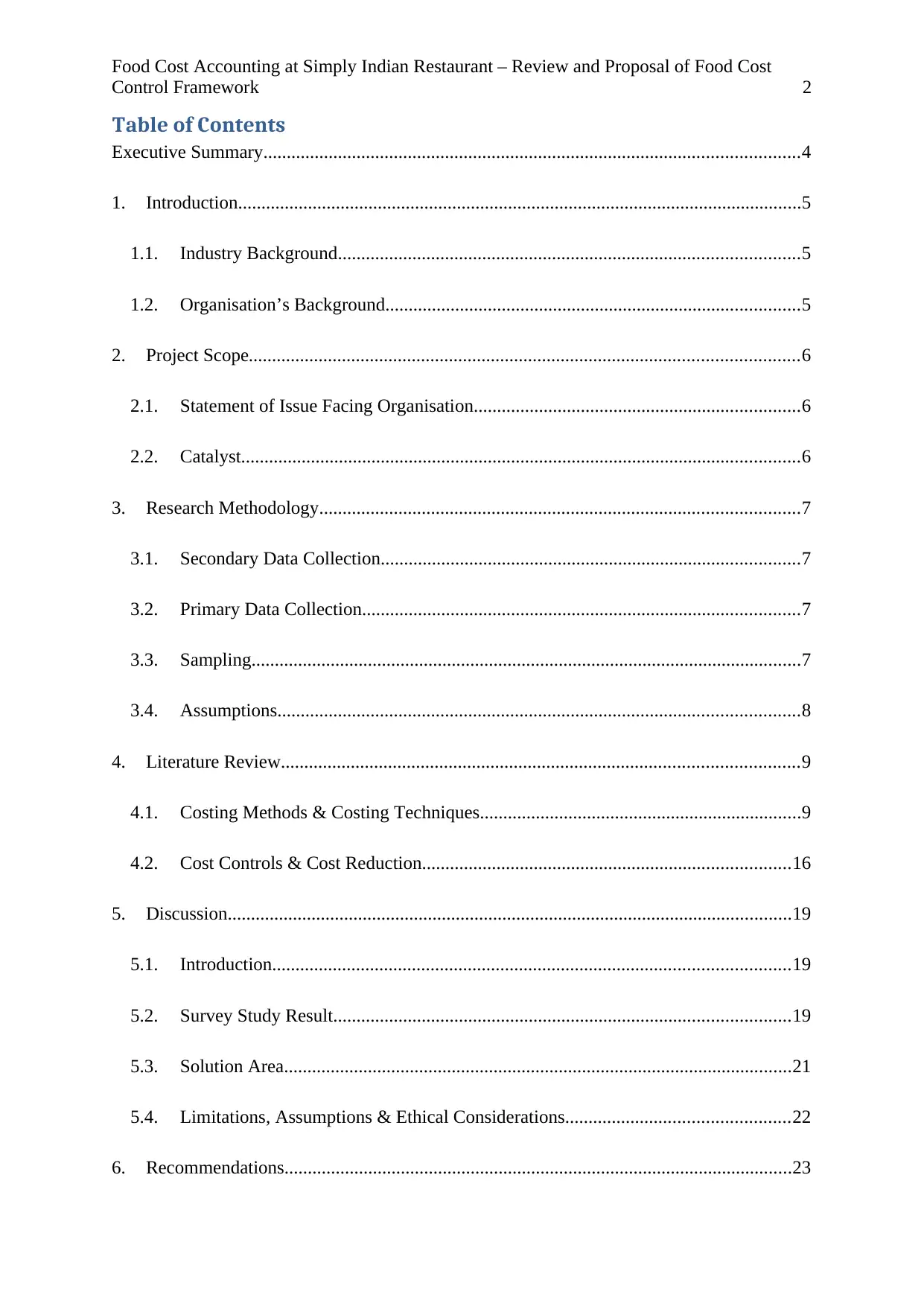
Food Cost Accounting at Simply Indian Restaurant – Review and Proposal of Food Cost
Control Framework 2
Table of Contents
Executive Summary...................................................................................................................4
1. Introduction.........................................................................................................................5
1.1. Industry Background...................................................................................................5
1.2. Organisation’s Background.........................................................................................5
2. Project Scope......................................................................................................................6
2.1. Statement of Issue Facing Organisation......................................................................6
2.2. Catalyst........................................................................................................................6
3. Research Methodology.......................................................................................................7
3.1. Secondary Data Collection..........................................................................................7
3.2. Primary Data Collection..............................................................................................7
3.3. Sampling......................................................................................................................7
3.4. Assumptions................................................................................................................8
4. Literature Review...............................................................................................................9
4.1. Costing Methods & Costing Techniques.....................................................................9
4.2. Cost Controls & Cost Reduction...............................................................................16
5. Discussion.........................................................................................................................19
5.1. Introduction...............................................................................................................19
5.2. Survey Study Result..................................................................................................19
5.3. Solution Area.............................................................................................................21
5.4. Limitations, Assumptions & Ethical Considerations................................................22
6. Recommendations.............................................................................................................23
Control Framework 2
Table of Contents
Executive Summary...................................................................................................................4
1. Introduction.........................................................................................................................5
1.1. Industry Background...................................................................................................5
1.2. Organisation’s Background.........................................................................................5
2. Project Scope......................................................................................................................6
2.1. Statement of Issue Facing Organisation......................................................................6
2.2. Catalyst........................................................................................................................6
3. Research Methodology.......................................................................................................7
3.1. Secondary Data Collection..........................................................................................7
3.2. Primary Data Collection..............................................................................................7
3.3. Sampling......................................................................................................................7
3.4. Assumptions................................................................................................................8
4. Literature Review...............................................................................................................9
4.1. Costing Methods & Costing Techniques.....................................................................9
4.2. Cost Controls & Cost Reduction...............................................................................16
5. Discussion.........................................................................................................................19
5.1. Introduction...............................................................................................................19
5.2. Survey Study Result..................................................................................................19
5.3. Solution Area.............................................................................................................21
5.4. Limitations, Assumptions & Ethical Considerations................................................22
6. Recommendations.............................................................................................................23
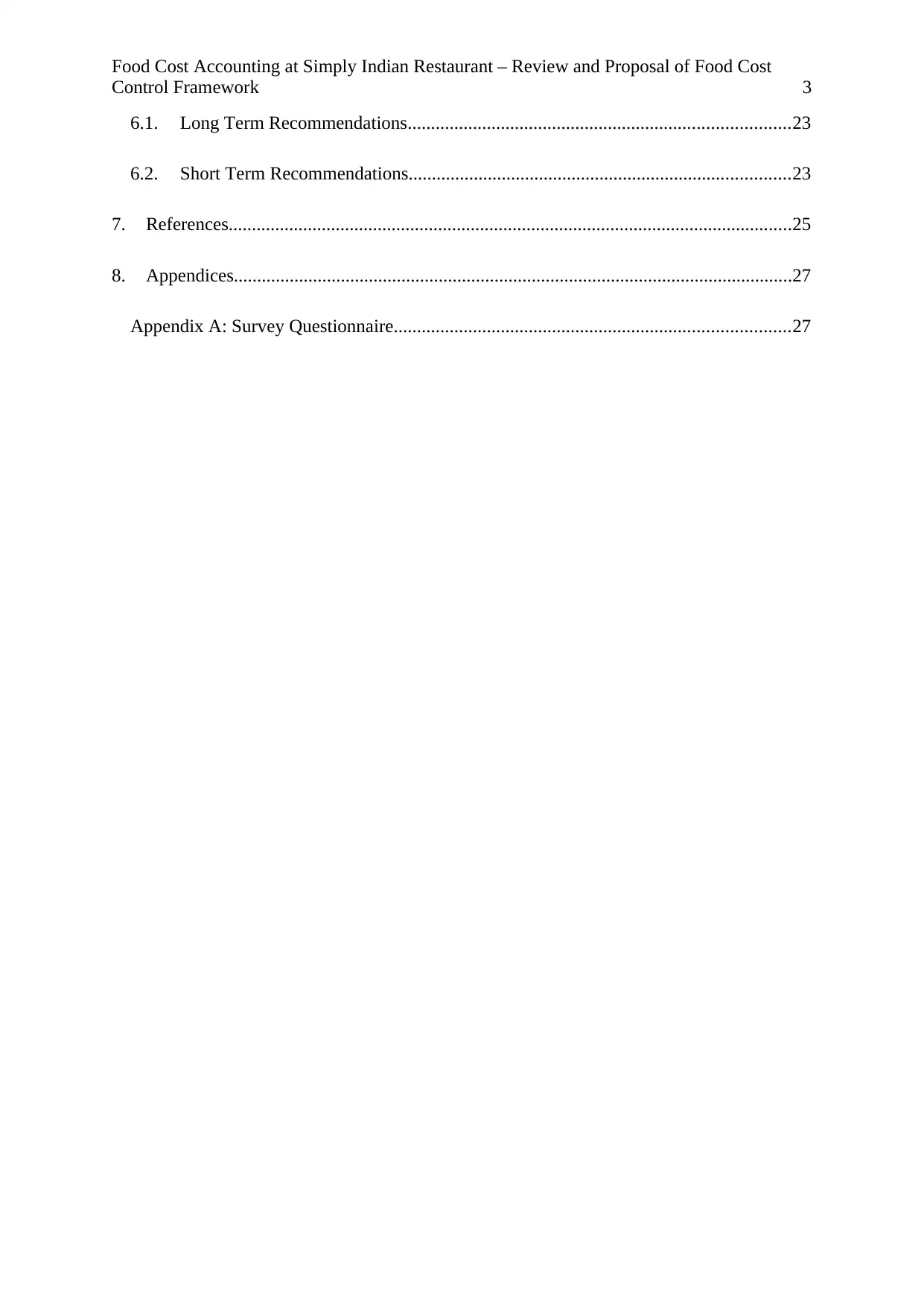
Food Cost Accounting at Simply Indian Restaurant – Review and Proposal of Food Cost
Control Framework 3
6.1. Long Term Recommendations..................................................................................23
6.2. Short Term Recommendations..................................................................................23
7. References.........................................................................................................................25
8. Appendices........................................................................................................................27
Appendix A: Survey Questionnaire.....................................................................................27
Control Framework 3
6.1. Long Term Recommendations..................................................................................23
6.2. Short Term Recommendations..................................................................................23
7. References.........................................................................................................................25
8. Appendices........................................................................................................................27
Appendix A: Survey Questionnaire.....................................................................................27
⊘ This is a preview!⊘
Do you want full access?
Subscribe today to unlock all pages.

Trusted by 1+ million students worldwide
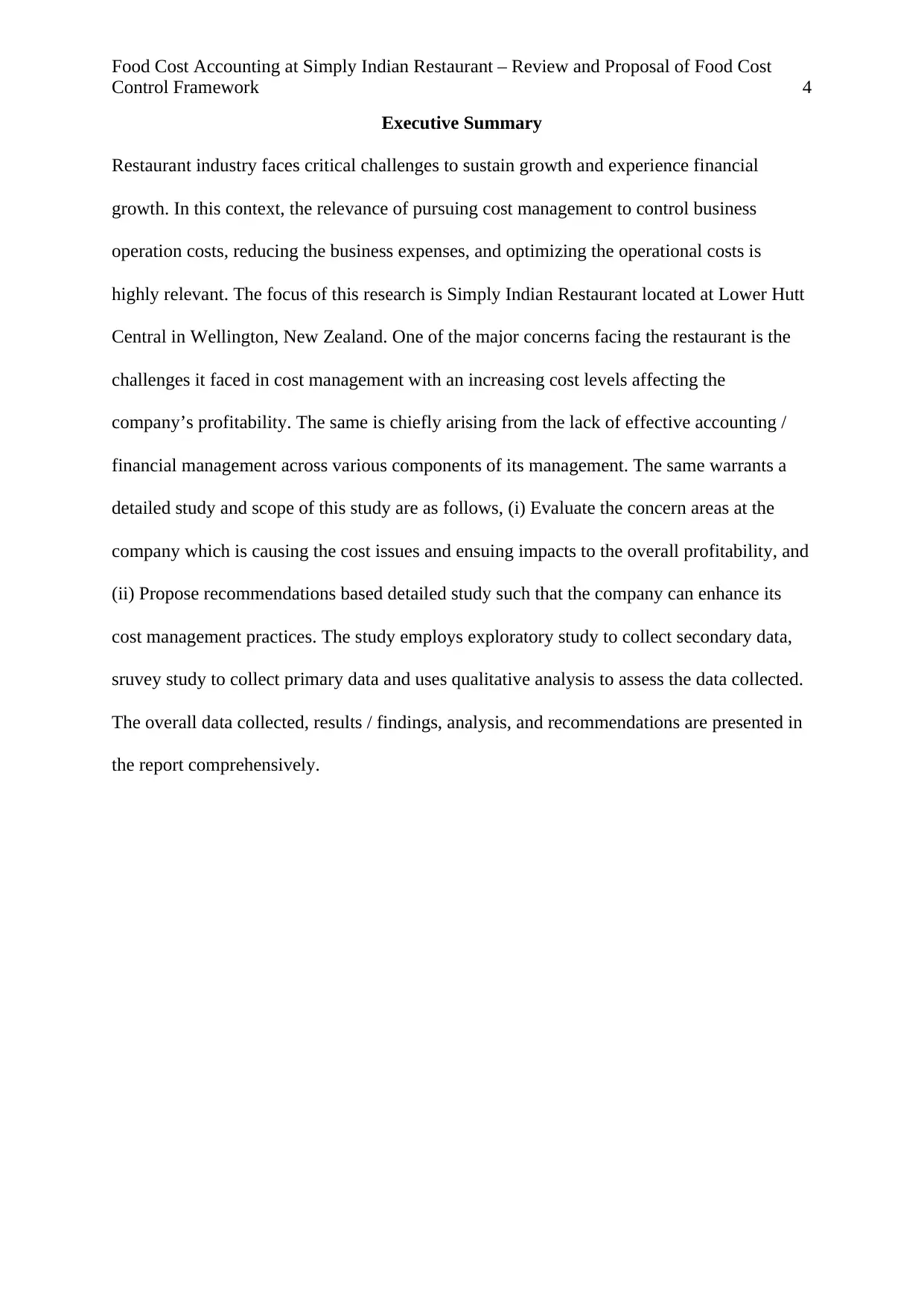
Food Cost Accounting at Simply Indian Restaurant – Review and Proposal of Food Cost
Control Framework 4
Executive Summary
Restaurant industry faces critical challenges to sustain growth and experience financial
growth. In this context, the relevance of pursuing cost management to control business
operation costs, reducing the business expenses, and optimizing the operational costs is
highly relevant. The focus of this research is Simply Indian Restaurant located at Lower Hutt
Central in Wellington, New Zealand. One of the major concerns facing the restaurant is the
challenges it faced in cost management with an increasing cost levels affecting the
company’s profitability. The same is chiefly arising from the lack of effective accounting /
financial management across various components of its management. The same warrants a
detailed study and scope of this study are as follows, (i) Evaluate the concern areas at the
company which is causing the cost issues and ensuing impacts to the overall profitability, and
(ii) Propose recommendations based detailed study such that the company can enhance its
cost management practices. The study employs exploratory study to collect secondary data,
sruvey study to collect primary data and uses qualitative analysis to assess the data collected.
The overall data collected, results / findings, analysis, and recommendations are presented in
the report comprehensively.
Control Framework 4
Executive Summary
Restaurant industry faces critical challenges to sustain growth and experience financial
growth. In this context, the relevance of pursuing cost management to control business
operation costs, reducing the business expenses, and optimizing the operational costs is
highly relevant. The focus of this research is Simply Indian Restaurant located at Lower Hutt
Central in Wellington, New Zealand. One of the major concerns facing the restaurant is the
challenges it faced in cost management with an increasing cost levels affecting the
company’s profitability. The same is chiefly arising from the lack of effective accounting /
financial management across various components of its management. The same warrants a
detailed study and scope of this study are as follows, (i) Evaluate the concern areas at the
company which is causing the cost issues and ensuing impacts to the overall profitability, and
(ii) Propose recommendations based detailed study such that the company can enhance its
cost management practices. The study employs exploratory study to collect secondary data,
sruvey study to collect primary data and uses qualitative analysis to assess the data collected.
The overall data collected, results / findings, analysis, and recommendations are presented in
the report comprehensively.
Paraphrase This Document
Need a fresh take? Get an instant paraphrase of this document with our AI Paraphraser
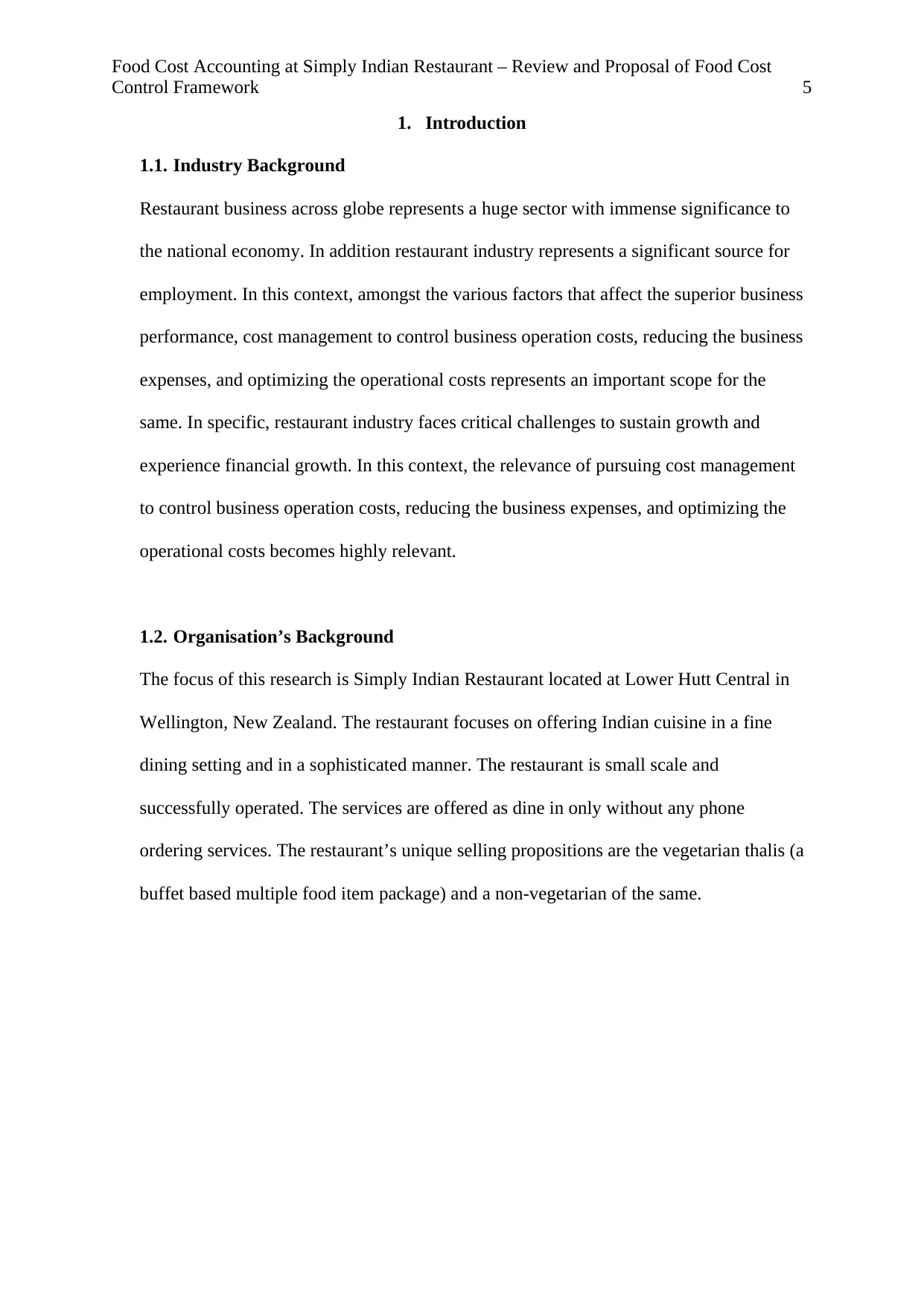
Food Cost Accounting at Simply Indian Restaurant – Review and Proposal of Food Cost
Control Framework 5
1. Introduction
1.1. Industry Background
Restaurant business across globe represents a huge sector with immense significance to
the national economy. In addition restaurant industry represents a significant source for
employment. In this context, amongst the various factors that affect the superior business
performance, cost management to control business operation costs, reducing the business
expenses, and optimizing the operational costs represents an important scope for the
same. In specific, restaurant industry faces critical challenges to sustain growth and
experience financial growth. In this context, the relevance of pursuing cost management
to control business operation costs, reducing the business expenses, and optimizing the
operational costs becomes highly relevant.
1.2. Organisation’s Background
The focus of this research is Simply Indian Restaurant located at Lower Hutt Central in
Wellington, New Zealand. The restaurant focuses on offering Indian cuisine in a fine
dining setting and in a sophisticated manner. The restaurant is small scale and
successfully operated. The services are offered as dine in only without any phone
ordering services. The restaurant’s unique selling propositions are the vegetarian thalis (a
buffet based multiple food item package) and a non-vegetarian of the same.
Control Framework 5
1. Introduction
1.1. Industry Background
Restaurant business across globe represents a huge sector with immense significance to
the national economy. In addition restaurant industry represents a significant source for
employment. In this context, amongst the various factors that affect the superior business
performance, cost management to control business operation costs, reducing the business
expenses, and optimizing the operational costs represents an important scope for the
same. In specific, restaurant industry faces critical challenges to sustain growth and
experience financial growth. In this context, the relevance of pursuing cost management
to control business operation costs, reducing the business expenses, and optimizing the
operational costs becomes highly relevant.
1.2. Organisation’s Background
The focus of this research is Simply Indian Restaurant located at Lower Hutt Central in
Wellington, New Zealand. The restaurant focuses on offering Indian cuisine in a fine
dining setting and in a sophisticated manner. The restaurant is small scale and
successfully operated. The services are offered as dine in only without any phone
ordering services. The restaurant’s unique selling propositions are the vegetarian thalis (a
buffet based multiple food item package) and a non-vegetarian of the same.
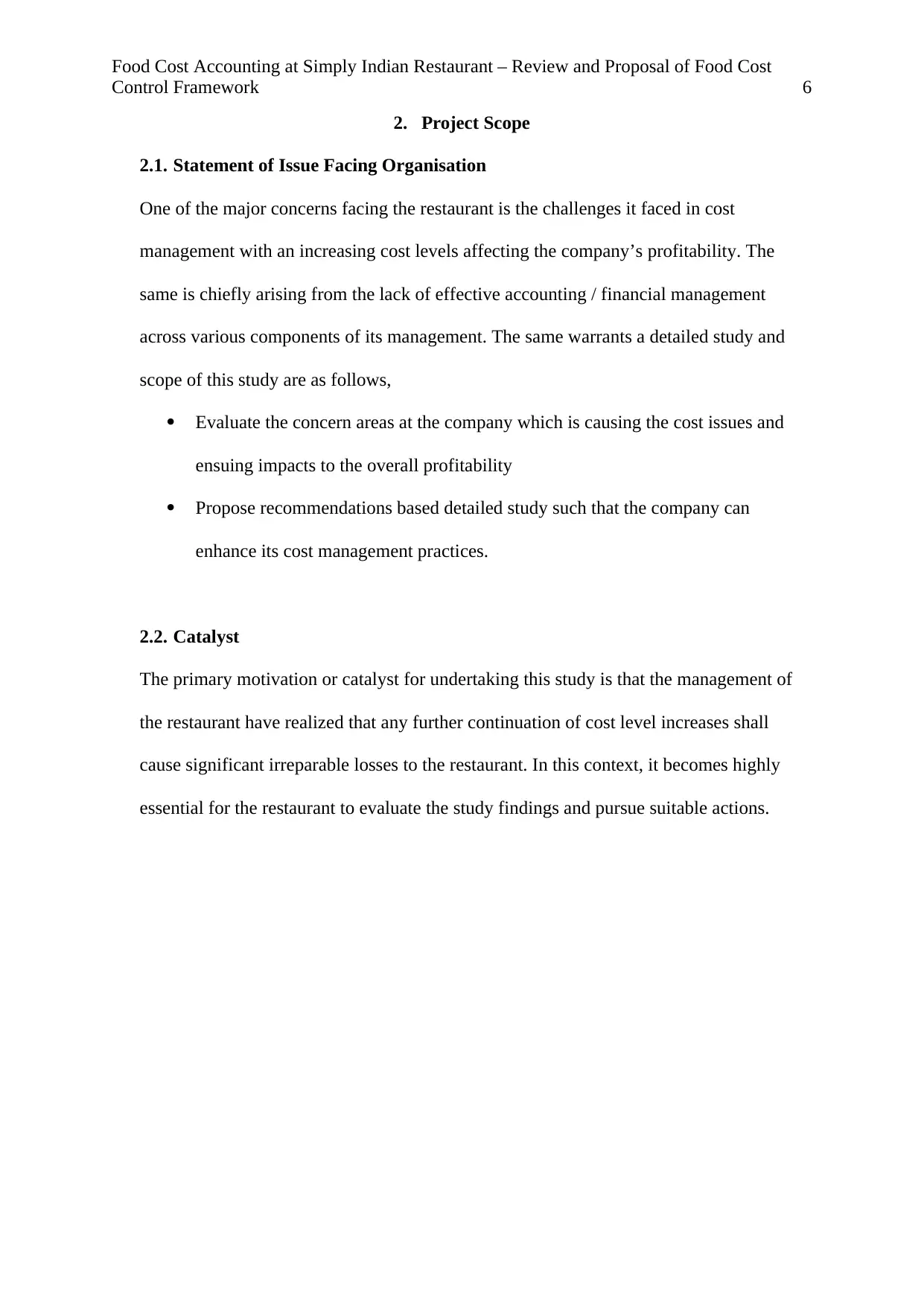
Food Cost Accounting at Simply Indian Restaurant – Review and Proposal of Food Cost
Control Framework 6
2. Project Scope
2.1. Statement of Issue Facing Organisation
One of the major concerns facing the restaurant is the challenges it faced in cost
management with an increasing cost levels affecting the company’s profitability. The
same is chiefly arising from the lack of effective accounting / financial management
across various components of its management. The same warrants a detailed study and
scope of this study are as follows,
Evaluate the concern areas at the company which is causing the cost issues and
ensuing impacts to the overall profitability
Propose recommendations based detailed study such that the company can
enhance its cost management practices.
2.2. Catalyst
The primary motivation or catalyst for undertaking this study is that the management of
the restaurant have realized that any further continuation of cost level increases shall
cause significant irreparable losses to the restaurant. In this context, it becomes highly
essential for the restaurant to evaluate the study findings and pursue suitable actions.
Control Framework 6
2. Project Scope
2.1. Statement of Issue Facing Organisation
One of the major concerns facing the restaurant is the challenges it faced in cost
management with an increasing cost levels affecting the company’s profitability. The
same is chiefly arising from the lack of effective accounting / financial management
across various components of its management. The same warrants a detailed study and
scope of this study are as follows,
Evaluate the concern areas at the company which is causing the cost issues and
ensuing impacts to the overall profitability
Propose recommendations based detailed study such that the company can
enhance its cost management practices.
2.2. Catalyst
The primary motivation or catalyst for undertaking this study is that the management of
the restaurant have realized that any further continuation of cost level increases shall
cause significant irreparable losses to the restaurant. In this context, it becomes highly
essential for the restaurant to evaluate the study findings and pursue suitable actions.
⊘ This is a preview!⊘
Do you want full access?
Subscribe today to unlock all pages.

Trusted by 1+ million students worldwide
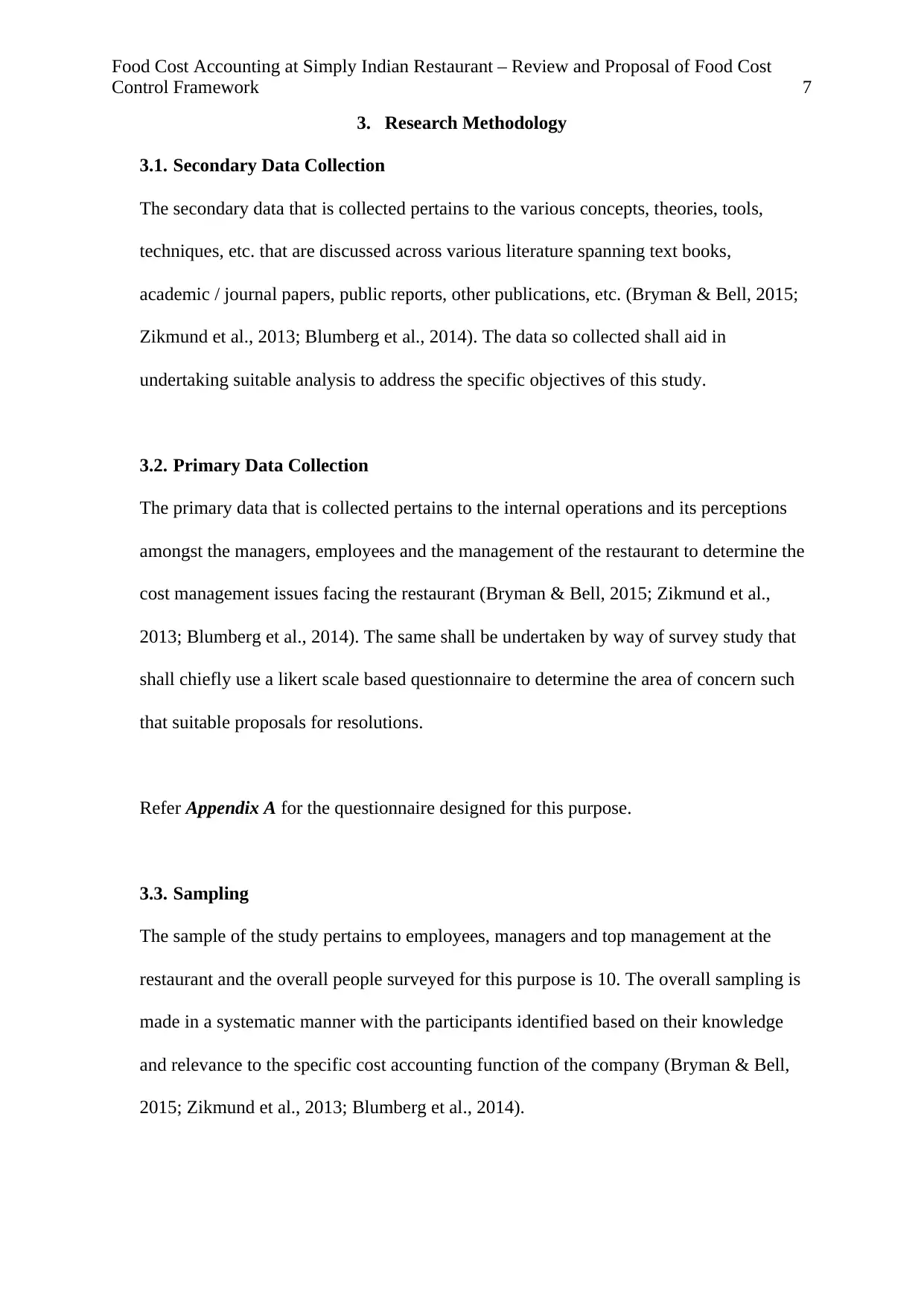
Food Cost Accounting at Simply Indian Restaurant – Review and Proposal of Food Cost
Control Framework 7
3. Research Methodology
3.1. Secondary Data Collection
The secondary data that is collected pertains to the various concepts, theories, tools,
techniques, etc. that are discussed across various literature spanning text books,
academic / journal papers, public reports, other publications, etc. (Bryman & Bell, 2015;
Zikmund et al., 2013; Blumberg et al., 2014). The data so collected shall aid in
undertaking suitable analysis to address the specific objectives of this study.
3.2. Primary Data Collection
The primary data that is collected pertains to the internal operations and its perceptions
amongst the managers, employees and the management of the restaurant to determine the
cost management issues facing the restaurant (Bryman & Bell, 2015; Zikmund et al.,
2013; Blumberg et al., 2014). The same shall be undertaken by way of survey study that
shall chiefly use a likert scale based questionnaire to determine the area of concern such
that suitable proposals for resolutions.
Refer Appendix A for the questionnaire designed for this purpose.
3.3. Sampling
The sample of the study pertains to employees, managers and top management at the
restaurant and the overall people surveyed for this purpose is 10. The overall sampling is
made in a systematic manner with the participants identified based on their knowledge
and relevance to the specific cost accounting function of the company (Bryman & Bell,
2015; Zikmund et al., 2013; Blumberg et al., 2014).
Control Framework 7
3. Research Methodology
3.1. Secondary Data Collection
The secondary data that is collected pertains to the various concepts, theories, tools,
techniques, etc. that are discussed across various literature spanning text books,
academic / journal papers, public reports, other publications, etc. (Bryman & Bell, 2015;
Zikmund et al., 2013; Blumberg et al., 2014). The data so collected shall aid in
undertaking suitable analysis to address the specific objectives of this study.
3.2. Primary Data Collection
The primary data that is collected pertains to the internal operations and its perceptions
amongst the managers, employees and the management of the restaurant to determine the
cost management issues facing the restaurant (Bryman & Bell, 2015; Zikmund et al.,
2013; Blumberg et al., 2014). The same shall be undertaken by way of survey study that
shall chiefly use a likert scale based questionnaire to determine the area of concern such
that suitable proposals for resolutions.
Refer Appendix A for the questionnaire designed for this purpose.
3.3. Sampling
The sample of the study pertains to employees, managers and top management at the
restaurant and the overall people surveyed for this purpose is 10. The overall sampling is
made in a systematic manner with the participants identified based on their knowledge
and relevance to the specific cost accounting function of the company (Bryman & Bell,
2015; Zikmund et al., 2013; Blumberg et al., 2014).
Paraphrase This Document
Need a fresh take? Get an instant paraphrase of this document with our AI Paraphraser
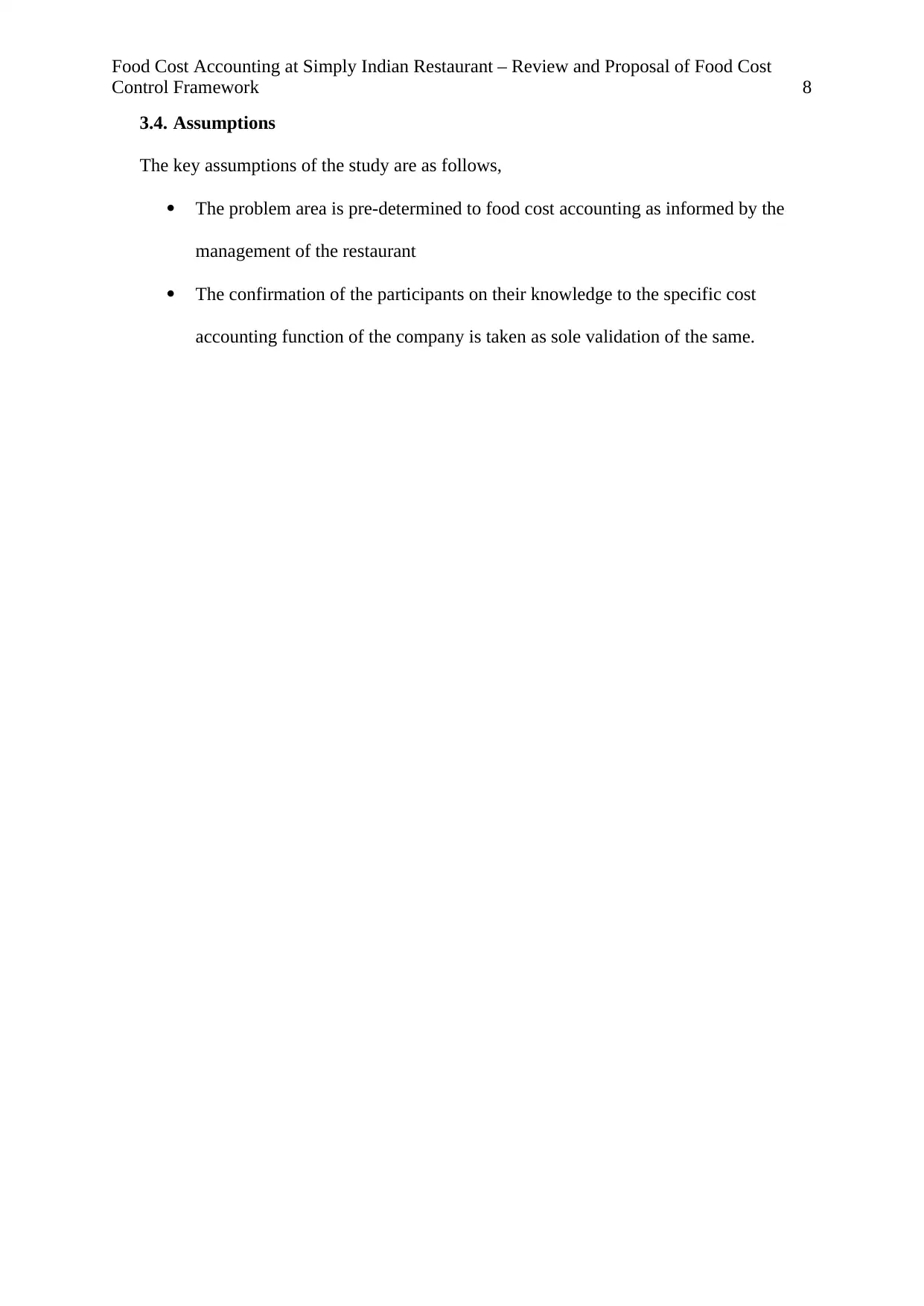
Food Cost Accounting at Simply Indian Restaurant – Review and Proposal of Food Cost
Control Framework 8
3.4. Assumptions
The key assumptions of the study are as follows,
The problem area is pre-determined to food cost accounting as informed by the
management of the restaurant
The confirmation of the participants on their knowledge to the specific cost
accounting function of the company is taken as sole validation of the same.
Control Framework 8
3.4. Assumptions
The key assumptions of the study are as follows,
The problem area is pre-determined to food cost accounting as informed by the
management of the restaurant
The confirmation of the participants on their knowledge to the specific cost
accounting function of the company is taken as sole validation of the same.
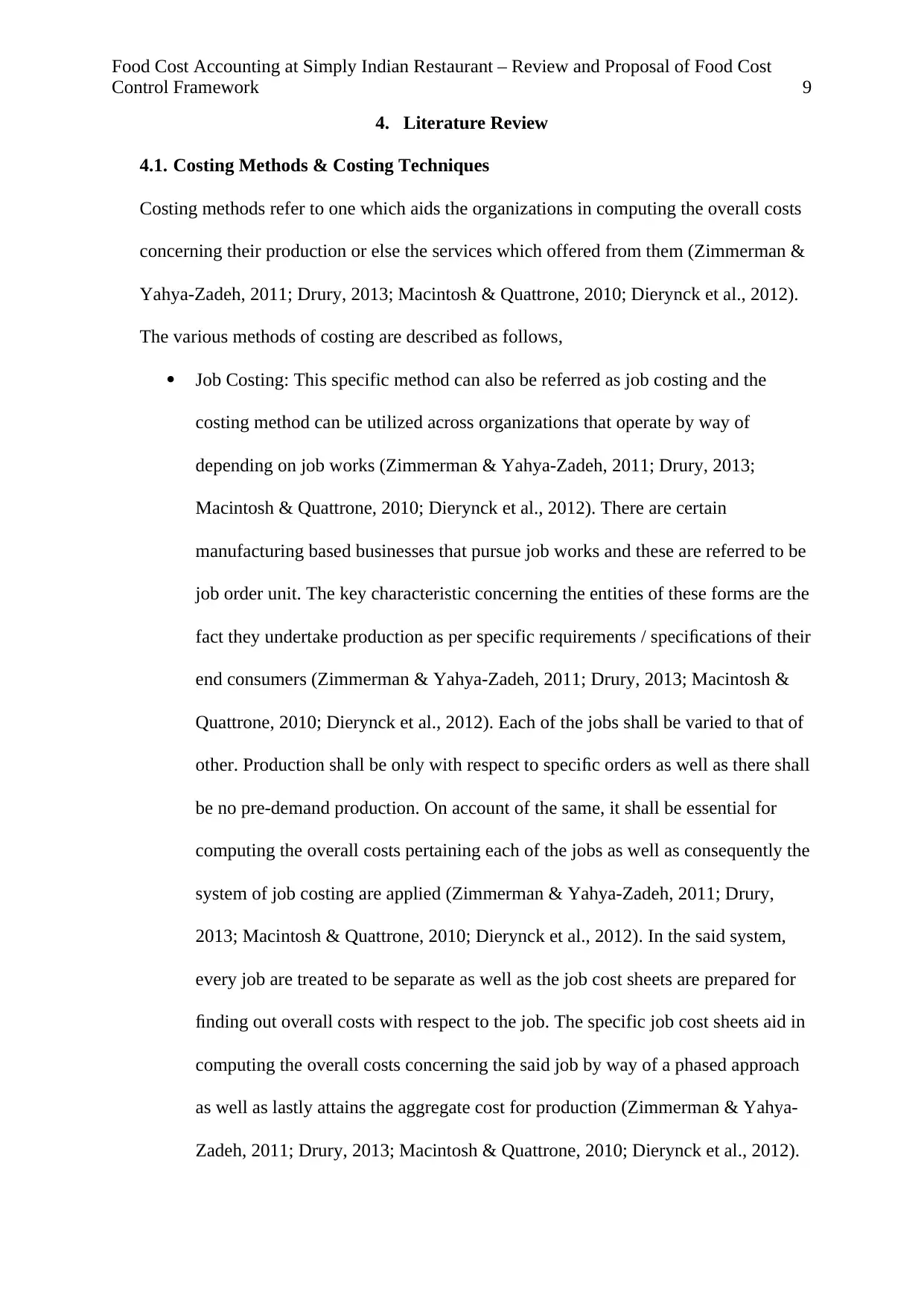
Food Cost Accounting at Simply Indian Restaurant – Review and Proposal of Food Cost
Control Framework 9
4. Literature Review
4.1. Costing Methods & Costing Techniques
Costing methods refer to one which aids the organizations in computing the overall costs
concerning their production or else the services which offered from them (Zimmerman &
Yahya-Zadeh, 2011; Drury, 2013; Macintosh & Quattrone, 2010; Dierynck et al., 2012).
The various methods of costing are described as follows,
Job Costing: This specific method can also be referred as job costing and the
costing method can be utilized across organizations that operate by way of
depending on job works (Zimmerman & Yahya-Zadeh, 2011; Drury, 2013;
Macintosh & Quattrone, 2010; Dierynck et al., 2012). There are certain
manufacturing based businesses that pursue job works and these are referred to be
job order unit. The key characteristic concerning the entities of these forms are the
fact they undertake production as per specific requirements / specifications of their
end consumers (Zimmerman & Yahya-Zadeh, 2011; Drury, 2013; Macintosh &
Quattrone, 2010; Dierynck et al., 2012). Each of the jobs shall be varied to that of
other. Production shall be only with respect to specific orders as well as there shall
be no pre-demand production. On account of the same, it shall be essential for
computing the overall costs pertaining each of the jobs as well as consequently the
system of job costing are applied (Zimmerman & Yahya-Zadeh, 2011; Drury,
2013; Macintosh & Quattrone, 2010; Dierynck et al., 2012). In the said system,
every job are treated to be separate as well as the job cost sheets are prepared for
finding out overall costs with respect to the job. The specific job cost sheets aid in
computing the overall costs concerning the said job by way of a phased approach
as well as lastly attains the aggregate cost for production (Zimmerman & Yahya-
Zadeh, 2011; Drury, 2013; Macintosh & Quattrone, 2010; Dierynck et al., 2012).
Control Framework 9
4. Literature Review
4.1. Costing Methods & Costing Techniques
Costing methods refer to one which aids the organizations in computing the overall costs
concerning their production or else the services which offered from them (Zimmerman &
Yahya-Zadeh, 2011; Drury, 2013; Macintosh & Quattrone, 2010; Dierynck et al., 2012).
The various methods of costing are described as follows,
Job Costing: This specific method can also be referred as job costing and the
costing method can be utilized across organizations that operate by way of
depending on job works (Zimmerman & Yahya-Zadeh, 2011; Drury, 2013;
Macintosh & Quattrone, 2010; Dierynck et al., 2012). There are certain
manufacturing based businesses that pursue job works and these are referred to be
job order unit. The key characteristic concerning the entities of these forms are the
fact they undertake production as per specific requirements / specifications of their
end consumers (Zimmerman & Yahya-Zadeh, 2011; Drury, 2013; Macintosh &
Quattrone, 2010; Dierynck et al., 2012). Each of the jobs shall be varied to that of
other. Production shall be only with respect to specific orders as well as there shall
be no pre-demand production. On account of the same, it shall be essential for
computing the overall costs pertaining each of the jobs as well as consequently the
system of job costing are applied (Zimmerman & Yahya-Zadeh, 2011; Drury,
2013; Macintosh & Quattrone, 2010; Dierynck et al., 2012). In the said system,
every job are treated to be separate as well as the job cost sheets are prepared for
finding out overall costs with respect to the job. The specific job cost sheets aid in
computing the overall costs concerning the said job by way of a phased approach
as well as lastly attains the aggregate cost for production (Zimmerman & Yahya-
Zadeh, 2011; Drury, 2013; Macintosh & Quattrone, 2010; Dierynck et al., 2012).
⊘ This is a preview!⊘
Do you want full access?
Subscribe today to unlock all pages.

Trusted by 1+ million students worldwide
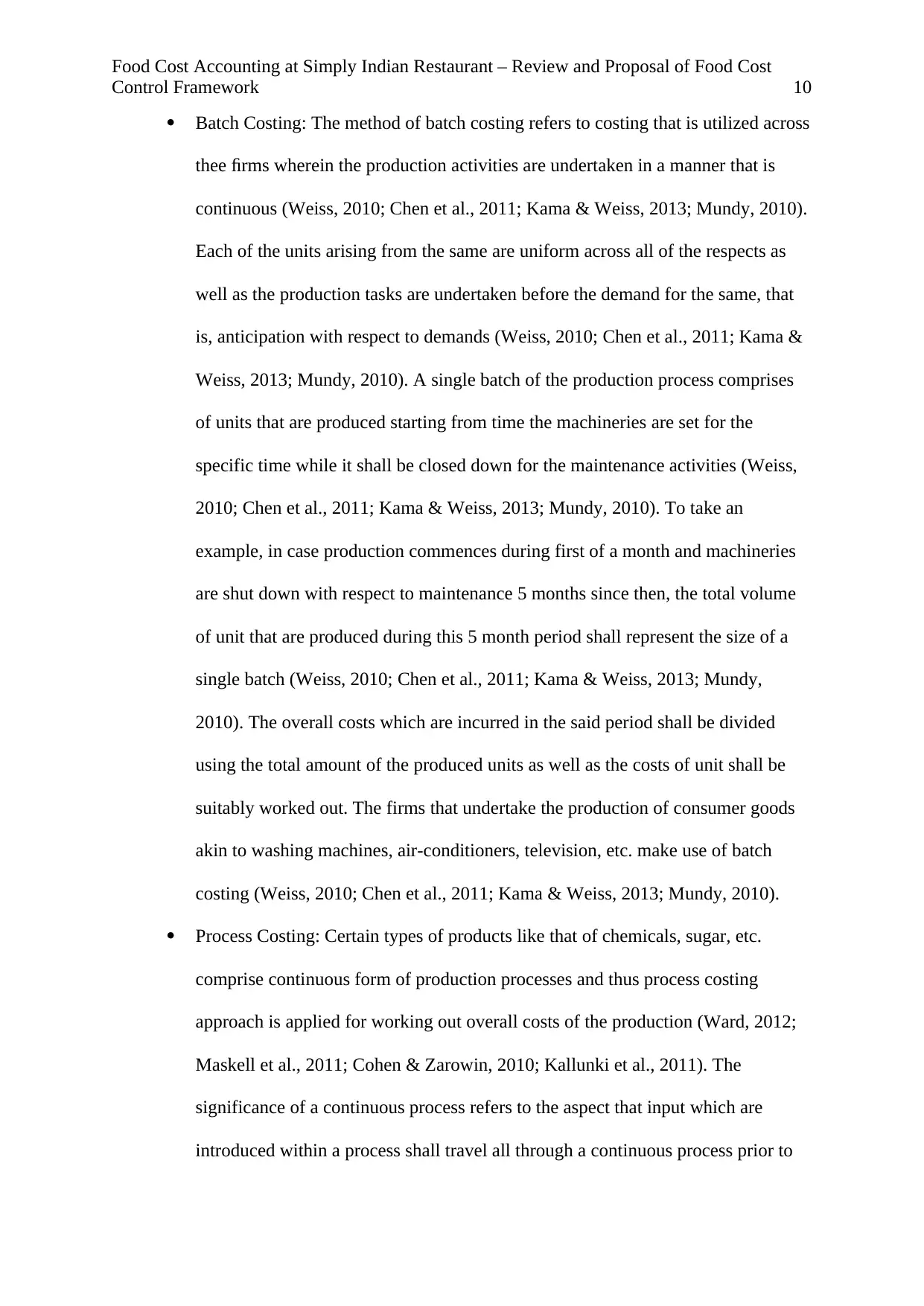
Food Cost Accounting at Simply Indian Restaurant – Review and Proposal of Food Cost
Control Framework 10
Batch Costing: The method of batch costing refers to costing that is utilized across
thee firms wherein the production activities are undertaken in a manner that is
continuous (Weiss, 2010; Chen et al., 2011; Kama & Weiss, 2013; Mundy, 2010).
Each of the units arising from the same are uniform across all of the respects as
well as the production tasks are undertaken before the demand for the same, that
is, anticipation with respect to demands (Weiss, 2010; Chen et al., 2011; Kama &
Weiss, 2013; Mundy, 2010). A single batch of the production process comprises
of units that are produced starting from time the machineries are set for the
specific time while it shall be closed down for the maintenance activities (Weiss,
2010; Chen et al., 2011; Kama & Weiss, 2013; Mundy, 2010). To take an
example, in case production commences during first of a month and machineries
are shut down with respect to maintenance 5 months since then, the total volume
of unit that are produced during this 5 month period shall represent the size of a
single batch (Weiss, 2010; Chen et al., 2011; Kama & Weiss, 2013; Mundy,
2010). The overall costs which are incurred in the said period shall be divided
using the total amount of the produced units as well as the costs of unit shall be
suitably worked out. The firms that undertake the production of consumer goods
akin to washing machines, air-conditioners, television, etc. make use of batch
costing (Weiss, 2010; Chen et al., 2011; Kama & Weiss, 2013; Mundy, 2010).
Process Costing: Certain types of products like that of chemicals, sugar, etc.
comprise continuous form of production processes and thus process costing
approach is applied for working out overall costs of the production (Ward, 2012;
Maskell et al., 2011; Cohen & Zarowin, 2010; Kallunki et al., 2011). The
significance of a continuous process refers to the aspect that input which are
introduced within a process shall travel all through a continuous process prior to
Control Framework 10
Batch Costing: The method of batch costing refers to costing that is utilized across
thee firms wherein the production activities are undertaken in a manner that is
continuous (Weiss, 2010; Chen et al., 2011; Kama & Weiss, 2013; Mundy, 2010).
Each of the units arising from the same are uniform across all of the respects as
well as the production tasks are undertaken before the demand for the same, that
is, anticipation with respect to demands (Weiss, 2010; Chen et al., 2011; Kama &
Weiss, 2013; Mundy, 2010). A single batch of the production process comprises
of units that are produced starting from time the machineries are set for the
specific time while it shall be closed down for the maintenance activities (Weiss,
2010; Chen et al., 2011; Kama & Weiss, 2013; Mundy, 2010). To take an
example, in case production commences during first of a month and machineries
are shut down with respect to maintenance 5 months since then, the total volume
of unit that are produced during this 5 month period shall represent the size of a
single batch (Weiss, 2010; Chen et al., 2011; Kama & Weiss, 2013; Mundy,
2010). The overall costs which are incurred in the said period shall be divided
using the total amount of the produced units as well as the costs of unit shall be
suitably worked out. The firms that undertake the production of consumer goods
akin to washing machines, air-conditioners, television, etc. make use of batch
costing (Weiss, 2010; Chen et al., 2011; Kama & Weiss, 2013; Mundy, 2010).
Process Costing: Certain types of products like that of chemicals, sugar, etc.
comprise continuous form of production processes and thus process costing
approach is applied for working out overall costs of the production (Ward, 2012;
Maskell et al., 2011; Cohen & Zarowin, 2010; Kallunki et al., 2011). The
significance of a continuous process refers to the aspect that input which are
introduced within a process shall travel all through a continuous process prior to
Paraphrase This Document
Need a fresh take? Get an instant paraphrase of this document with our AI Paraphraser
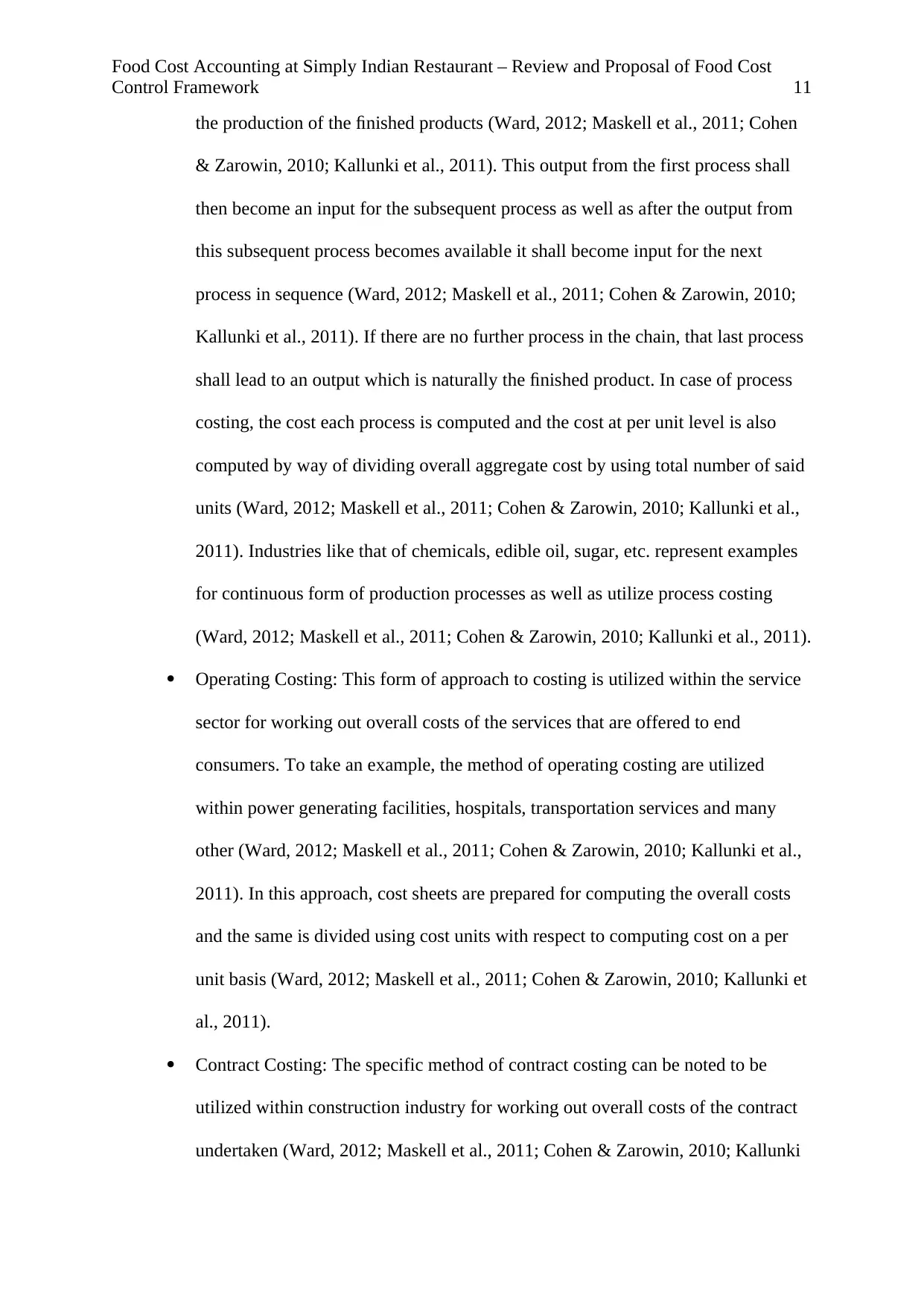
Food Cost Accounting at Simply Indian Restaurant – Review and Proposal of Food Cost
Control Framework 11
the production of the finished products (Ward, 2012; Maskell et al., 2011; Cohen
& Zarowin, 2010; Kallunki et al., 2011). This output from the first process shall
then become an input for the subsequent process as well as after the output from
this subsequent process becomes available it shall become input for the next
process in sequence (Ward, 2012; Maskell et al., 2011; Cohen & Zarowin, 2010;
Kallunki et al., 2011). If there are no further process in the chain, that last process
shall lead to an output which is naturally the finished product. In case of process
costing, the cost each process is computed and the cost at per unit level is also
computed by way of dividing overall aggregate cost by using total number of said
units (Ward, 2012; Maskell et al., 2011; Cohen & Zarowin, 2010; Kallunki et al.,
2011). Industries like that of chemicals, edible oil, sugar, etc. represent examples
for continuous form of production processes as well as utilize process costing
(Ward, 2012; Maskell et al., 2011; Cohen & Zarowin, 2010; Kallunki et al., 2011).
Operating Costing: This form of approach to costing is utilized within the service
sector for working out overall costs of the services that are offered to end
consumers. To take an example, the method of operating costing are utilized
within power generating facilities, hospitals, transportation services and many
other (Ward, 2012; Maskell et al., 2011; Cohen & Zarowin, 2010; Kallunki et al.,
2011). In this approach, cost sheets are prepared for computing the overall costs
and the same is divided using cost units with respect to computing cost on a per
unit basis (Ward, 2012; Maskell et al., 2011; Cohen & Zarowin, 2010; Kallunki et
al., 2011).
Contract Costing: The specific method of contract costing can be noted to be
utilized within construction industry for working out overall costs of the contract
undertaken (Ward, 2012; Maskell et al., 2011; Cohen & Zarowin, 2010; Kallunki
Control Framework 11
the production of the finished products (Ward, 2012; Maskell et al., 2011; Cohen
& Zarowin, 2010; Kallunki et al., 2011). This output from the first process shall
then become an input for the subsequent process as well as after the output from
this subsequent process becomes available it shall become input for the next
process in sequence (Ward, 2012; Maskell et al., 2011; Cohen & Zarowin, 2010;
Kallunki et al., 2011). If there are no further process in the chain, that last process
shall lead to an output which is naturally the finished product. In case of process
costing, the cost each process is computed and the cost at per unit level is also
computed by way of dividing overall aggregate cost by using total number of said
units (Ward, 2012; Maskell et al., 2011; Cohen & Zarowin, 2010; Kallunki et al.,
2011). Industries like that of chemicals, edible oil, sugar, etc. represent examples
for continuous form of production processes as well as utilize process costing
(Ward, 2012; Maskell et al., 2011; Cohen & Zarowin, 2010; Kallunki et al., 2011).
Operating Costing: This form of approach to costing is utilized within the service
sector for working out overall costs of the services that are offered to end
consumers. To take an example, the method of operating costing are utilized
within power generating facilities, hospitals, transportation services and many
other (Ward, 2012; Maskell et al., 2011; Cohen & Zarowin, 2010; Kallunki et al.,
2011). In this approach, cost sheets are prepared for computing the overall costs
and the same is divided using cost units with respect to computing cost on a per
unit basis (Ward, 2012; Maskell et al., 2011; Cohen & Zarowin, 2010; Kallunki et
al., 2011).
Contract Costing: The specific method of contract costing can be noted to be
utilized within construction industry for working out overall costs of the contract
undertaken (Ward, 2012; Maskell et al., 2011; Cohen & Zarowin, 2010; Kallunki
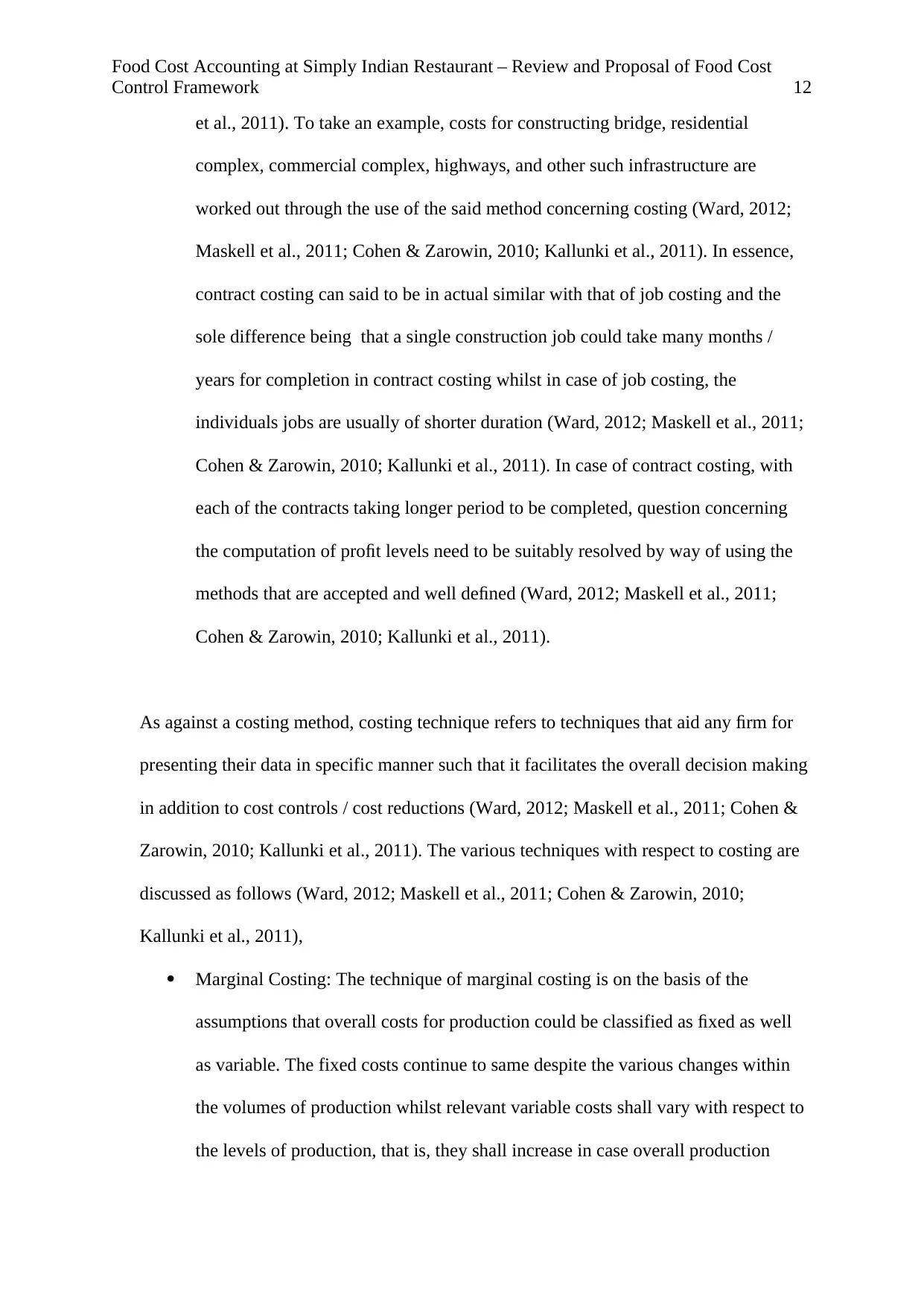
Food Cost Accounting at Simply Indian Restaurant – Review and Proposal of Food Cost
Control Framework 12
et al., 2011). To take an example, costs for constructing bridge, residential
complex, commercial complex, highways, and other such infrastructure are
worked out through the use of the said method concerning costing (Ward, 2012;
Maskell et al., 2011; Cohen & Zarowin, 2010; Kallunki et al., 2011). In essence,
contract costing can said to be in actual similar with that of job costing and the
sole difference being that a single construction job could take many months /
years for completion in contract costing whilst in case of job costing, the
individuals jobs are usually of shorter duration (Ward, 2012; Maskell et al., 2011;
Cohen & Zarowin, 2010; Kallunki et al., 2011). In case of contract costing, with
each of the contracts taking longer period to be completed, question concerning
the computation of profit levels need to be suitably resolved by way of using the
methods that are accepted and well defined (Ward, 2012; Maskell et al., 2011;
Cohen & Zarowin, 2010; Kallunki et al., 2011).
As against a costing method, costing technique refers to techniques that aid any firm for
presenting their data in specific manner such that it facilitates the overall decision making
in addition to cost controls / cost reductions (Ward, 2012; Maskell et al., 2011; Cohen &
Zarowin, 2010; Kallunki et al., 2011). The various techniques with respect to costing are
discussed as follows (Ward, 2012; Maskell et al., 2011; Cohen & Zarowin, 2010;
Kallunki et al., 2011),
Marginal Costing: The technique of marginal costing is on the basis of the
assumptions that overall costs for production could be classified as fixed as well
as variable. The fixed costs continue to same despite the various changes within
the volumes of production whilst relevant variable costs shall vary with respect to
the levels of production, that is, they shall increase in case overall production
Control Framework 12
et al., 2011). To take an example, costs for constructing bridge, residential
complex, commercial complex, highways, and other such infrastructure are
worked out through the use of the said method concerning costing (Ward, 2012;
Maskell et al., 2011; Cohen & Zarowin, 2010; Kallunki et al., 2011). In essence,
contract costing can said to be in actual similar with that of job costing and the
sole difference being that a single construction job could take many months /
years for completion in contract costing whilst in case of job costing, the
individuals jobs are usually of shorter duration (Ward, 2012; Maskell et al., 2011;
Cohen & Zarowin, 2010; Kallunki et al., 2011). In case of contract costing, with
each of the contracts taking longer period to be completed, question concerning
the computation of profit levels need to be suitably resolved by way of using the
methods that are accepted and well defined (Ward, 2012; Maskell et al., 2011;
Cohen & Zarowin, 2010; Kallunki et al., 2011).
As against a costing method, costing technique refers to techniques that aid any firm for
presenting their data in specific manner such that it facilitates the overall decision making
in addition to cost controls / cost reductions (Ward, 2012; Maskell et al., 2011; Cohen &
Zarowin, 2010; Kallunki et al., 2011). The various techniques with respect to costing are
discussed as follows (Ward, 2012; Maskell et al., 2011; Cohen & Zarowin, 2010;
Kallunki et al., 2011),
Marginal Costing: The technique of marginal costing is on the basis of the
assumptions that overall costs for production could be classified as fixed as well
as variable. The fixed costs continue to same despite the various changes within
the volumes of production whilst relevant variable costs shall vary with respect to
the levels of production, that is, they shall increase in case overall production
⊘ This is a preview!⊘
Do you want full access?
Subscribe today to unlock all pages.

Trusted by 1+ million students worldwide
1 out of 28
Related Documents
Your All-in-One AI-Powered Toolkit for Academic Success.
+13062052269
info@desklib.com
Available 24*7 on WhatsApp / Email
![[object Object]](/_next/static/media/star-bottom.7253800d.svg)
Unlock your academic potential
Copyright © 2020–2025 A2Z Services. All Rights Reserved. Developed and managed by ZUCOL.





